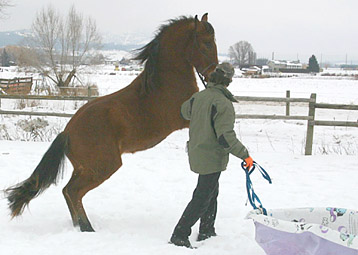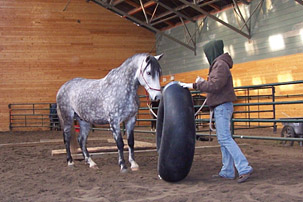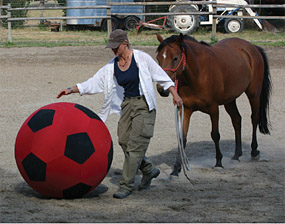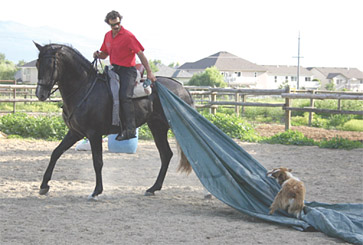Teaching in the Way of the Horse: Training For Courage, Part 1
by Paul Dufresne
People train horses for a multitude of disciplines, but they often forget or neglect one of the most important ingredients: courage. Horses need courage for almost every event, sooner or later. Whether someone just pleasure rides or whether they compete, if not just for safety's sake or to be as competitive as possible, they should know how brave their horse is when faced with adversity. Some people adopt the "wait and see" attitude, while others avoid absolutely anything that may potentially worry their horse; still others fly by the seat of their pants--sometimes literally.
Courage is a very significant ingredient to train for, although it may seem rather intangible to some people. Horses are born to be scared. If they weren't, they would not survive as a prey animal. They are also endowed with an incredible curiosity of anything new, but this is often tempered with a minute fuse, which mysteriously seems to be a victim of spontaneous combustion. Then you get to see first hand how explosive they are
How Do You Train For Courage?
When I am playing with horses, as soon as I feel that the horse starts to gain confidence in what I ask and starts to enjoy my company and touch, I begin to explore what worries my four-legged friend.
We have to remember that the natural explosiveness of a horse away from anything that could be conceived as threatening is likened to a phobia in human beings--they were just born with it. Rationalizing in human terms does not diffuse or alleviate the fear. How often do you see horses that are scared of a multitude of objects and are strapped down with some sort of physical restrictive device?

Once they are in this vise, they may even be expected to do fantastic athletic feats--and surprisingly, some do! This is similar to taking someone who is acrophobic (afraid of heights) and hobbling their legs so they can't run, then taking them up a mountain trail with a few cliffs. It's an accident waiting to happen.
Any animal that has a fear of anything needs to be motivated to overcome that fear, not forced. The key to overcoming a fear is that the animal has to be convinced that what they fear won't hurt them. To some, this may seem pretty complicated because it is not something that is easy to be objective about. It is not a race where we can time it and say, "Yeah, he's getting faster."
Have you ever dragged a plastic barrel by a rope on crispy snow near (unprepared) horses at liberty? What usually happens if you are within 25-50 feet is that the horses vacate the vicinity. The heads come up, and then the tails, they fart, and then they are gone.
Now, what if I did this with one horse at a time in a large pen, like an outdoor arena? If I started as far away as possible from the horse and proceeded to slowly drag the barrel on crispy snow, it would probably get the horse's undivided attention. How would I know whether the distance I started from was too close? Quite simply, if the horse does not leave or bolt, the distance was far enough that it didn't feel threatened. This is really important because if the horse did not appear concerned or scared, many people would think, "Ah he's not scared. Let's get closer." This is not what we would do to build courage, and this is a classic error.
Patience and Reward
When training for courage, especially when we are not sure exactly how far to go before the horse is too worried, the smart thing to do is to take the scary thing away before it becomes too scary. When you take something away before the horse prepares to leave, you have actually ended the lesson, however short, with the horse being brave. You can tell the horse, "Good!" Pet it or treat it after saying "Good" (like clicker training) and leave, turning your focus away from the horse. This allows him to relax and even invites some horses to come forward and investigate. Make sure that if you want to praise and pet the horse, you leave the scary thing behind.
Come back a few seconds later and introduce the scary object again, just a little bit closer. The more successful you want to be at this, the smaller the steps you should make. This sort of skill takes a little time to cultivate because people become impatient and want to go for the whole nine yards now. "The slower you go, the faster you go!" This is often the difference that sets apart the successful trainer from the unsuccessful one. The advance and retreat pattern avoids coming straight at the horse or focusing on it with your eyes or body language like a predator. When done slowly, positively, in minute steps, I never have seen a horse fail yet.
This principle of introducing scary objects with an advance & retreat system tempered with praise and treats works absolutely with all horses. Heck, it even works with people! Remember, with operant conditioning we are offering an active behavioral choice that as soon as the horse reacts in a positive way, we apply the conditioned reinforcer ("GOOOOOD," petting, or a clicker if you like). The more consistent you are in using one word or action, the sooner an animal will associate that sound or feel with having done what you wanted and that you will make it feel good shortly. Even if the horse isn’t quite sure what it is you want, if you keep repeating and reinforcing they will figure it out. Remember, for a horse to really know or understand, it has to repeat an act at least 100 times. More is better.
Now that the horse has been brave for very short periods of time and I have applied the conditioned reinforcer, I quickly like to add a positive reinforcer such as a small treat (i.e., 1/4" piece of horse cookie or carrot).
Motivated Behavior
Many trainers would just allow the horse to be without discomfort as a motivator (or just leave it alone). I have found that when teaching any animal anything that may scare, irritate, or upset it, a positive reinforcer such as a treat shows the horse that there is something in it for him. Often, the initial feeling of irritation or wanting to leave is replaced by, "Oh, this is for me?"
As an example, a Paso mare which I gave no other option but to go up (teaching the levade) finally laid her ears back and reared a bit. She was totally upset and confused until I said, "Goooood" and offered a small piece of horse cookie.

Her ears came forward and boy did I have her attention! This mare has repeated and improved this maneuver like a happy dog for a little treat, not bad for a very opinionated mare. She no longer gets upset over being asked to do a levade--she actually looks forward to it. This mare even goes as far as repeating many of the maneuvers she knows when I come out to feed her, in the hope she will impress me and maybe get a treat. Sometimes I can't help myself. I laugh and yes, give her a treat. Sure, a horse can learn to do something just out of respect for your leadership, but somehow it just doesn't have the same pizzazz as a horse who can't wait to offer it to you.
Now, if I were on horseback and doing the courage exercise with the barrel, or anything else scary for that matter, I would repeat a similar sequence. I would have someone drag the noisy barrel at the far end of the arena. Then I would have my horse face the object, which he might already be looking at. If a horse faces something scary, it is already braver. How often have you seen a horse get scared of something and take off, and then half a mile later stop and look around like, "What was that thing I was scared of anyway?"
In keeping the horse focused on the scary thing, I allow it to stand and watch. If the horse doesn't offer to move away from it, I say, "GOOOD" and offer the treat. Should the horse want to leave, this means I misjudged my starting point and I am too close. Assuming my starting point was adequate, I ask my horse to move slightly forward and to the side. It is always easier to ask a horse to move slightly to the side rather than straight forward; you could say it unlocks them. By not allowing the horse to assume a position of resistance, I am less likely to get any. Now if the horse steps slightly forward, I stop and let him relax with praise and a treat, and then walk him away from the scary thing. Then I would come back just a little closer than the last sequence and repeat. Taking your time with this allows for incredible results without using restraints of any sort

Creating the Courageous Horse
If I tied you, restrained you, and then told you I meant you no harm, would you believe me? This is what people do so often to their horses. Or they go further: they restrain a horse and then add scary situations or objects with no preparation. This is a loaded bomb waiting to explode, but we just don't know when. The best way to develop courage is to allow movement, then give the horse the responsibility to try and deal with it.
The object that you ask your horse to overcome doesn't really make your horse brave about any other unknown object, but the attitude and the trust you develop does apply to all situations. This is why it is so important to take your time. If you teach your horse to be brave and don't allow it to get hurt, it will develop incredible courage and overcome scary situations more and more readily. Remember, if you don't feel confident that it is safe, how can your horse? Also remember that younger horses are generally more scared because that is how they manage to survive and grow up to be older horses. They don't know what is safe and what isn't. As they get older they learn to discriminate better between what is safe and what is not. When done correctly, teaching horses how to be more courageous accelerates the process of learning and expands their limits
This method is a great way for leaders to start getting in control of their horses' fears and their own, and the first simple step to leading our horses more safely. Next month, we'll look at a more evolved approach of leading by example in Part 2 of "Training for Courage." It will explore herd dynamics and leadership so that we can get maximize our control over our horse's fear of new or old situations.
When you explore courage-building in a planned, methodical way, you learn to read your horse better and truly start to understand what is safe and what is not. Once we know a situation can't hurt us, we and/or the horses can all be brave. Plan for courage today!
